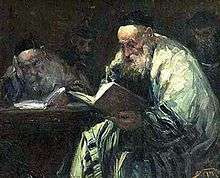Exodus Rabbah
Exodus Rabbah (Hebrew: שמות רבה, Shemot Rabbah) is the midrash to Exodus, containing in the printed editions 52 parashiyyot. It is not uniform in its composition.
Structure
In parashiyyot i.-xiv. the proems are almost invariably followed by the running commentary on the entire seder or other Scriptural division (the beginnings of the sedarim are distinguished by an asterisk):
- Parashah i., on *Ex. i. 1-ii. 25;
- par. ii. and iii., on *Ex. iii. 1-iv. 17;
- par. iv. and v., Nos.2-8, on *Ex. iv. 18-26;
- par. v., Nos. 1, 9-23, on Ex. iv. 27-vi. 1;
- par. vi., on *Ex. vi. 2-12;
- par. vii., on Ex. vi. 13 et seq.;
- par. viii., on Ex. vii. 1 et seq. (a Tanḥuma homily);
- par. ix., on *Ex. vii. 8-25;
- par x., on Ex. vii. 26-viii. 15;
- par. xi., on *Ex. viii. 16-ix. 12;
- par. xii., on Ex. ix. 13-35;
- par. xiii., on *Ex. x. 1-20;
- par. xiv., on Ex. x. 21-29
There is no exposition nor, in the Tanḥuma midrashim, any homily to *Ex. xi. 1. Beginning with parashah xv., Exodus Rabbah contains homilies and homiletical fragments to the first verses of the Scripture sections. Many of the homilies are taken from the Tanḥumas, though parashiyyot xv., xvi.-xix., xx., xxx., and others show that the author had access also to homilies in many other sources. In the printed editions the text is sometimes abbreviated and the reader referred to such collections, as well as to the Pesiḳta; in parashah xxxix. the entire exposition of the Pesiḳta lesson Ki Tissa (Ex. xxx. 11) has been eliminated in this fashion.
| Rabbinical Eras |
|---|
Such references and abbreviations were doubtless made by later copyists. There is an interesting statement in parashah xliv. regarding the manner of treating a proem-text from the Psalms for the homily to Ex. xxxii. 13. The assumption is justified that Shemot Rabbah down to Ex. xii. 1, with which section the Mekilta begins, is based on an earlier exegetical midrash, constituting, perhaps, the continuation of Bereshit Rabbah. This would explain the fact that in the first part there are several parashiyyot to the open and closed Scripture sections, and that several expressions recall the terminology of the tannaitic midrash. Zunz ascribes the composition of the entire work to the 11th or 12th century; although, immediately following Bereshit Rabbah in the collection of the rabbot, it "is separated from the latter by 500 years" (G. V. p. 256).
References
 This article incorporates text from a publication now in the public domain: Singer, Isidore; et al., eds. (1901–1906). "article name needed". Jewish Encyclopedia. New York: Funk & Wagnalls Company.
This article incorporates text from a publication now in the public domain: Singer, Isidore; et al., eds. (1901–1906). "article name needed". Jewish Encyclopedia. New York: Funk & Wagnalls Company.
External links
- Jewish Encyclopedia article for Midrash Aggada, by Isidore Singer and J. Theodor. There is apparently no topic article especially for Shemot Rabbah.
